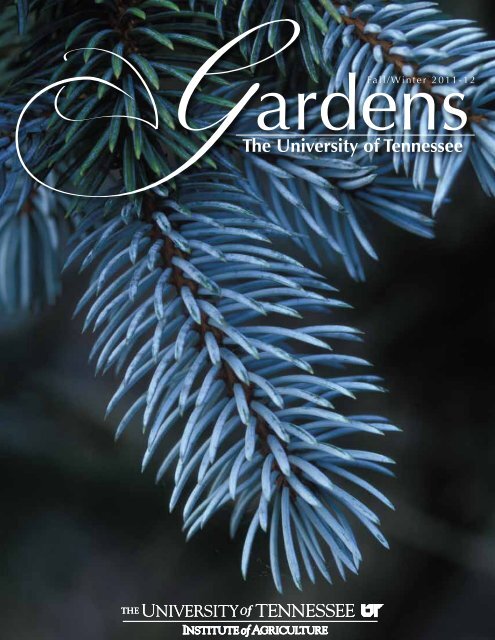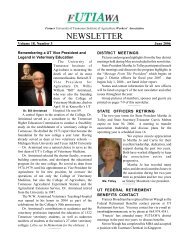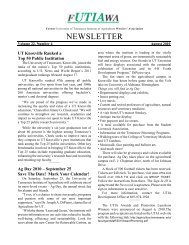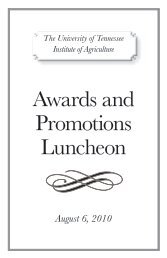Fall/Winter 2011-12 - UT Gardens - The University of Tennessee
Fall/Winter 2011-12 - UT Gardens - The University of Tennessee
Fall/Winter 2011-12 - UT Gardens - The University of Tennessee
You also want an ePaper? Increase the reach of your titles
YUMPU automatically turns print PDFs into web optimized ePapers that Google loves.
'Monham' Virginia creeperFavoritePerennial Vines, Part IBy Jason Reeves, <strong>UT</strong> <strong>Gardens</strong>, Jackson, research horticulturistWhen most people think perennial vine, perhaps the firstplant to come to mind is the overly enthusiastic Chinesewisteria, but there are many that are well behaved.Vines are many times the forgotten plants. Yet, their climbing habitadds significant dimension to the garden. Just as the lawn andground covers are considered the floor <strong>of</strong> the garden and trees andshrubs are the walls and ceilings, vines are the drapes and swags.<strong>The</strong>y can s<strong>of</strong>ten and enhance or hide and disguise architecturalfeatures. Vines can form a quick screen or extend limited gardenspace. <strong>The</strong>ir unique foliage, flowers or fruit can move the focalpoint above eye level, adding considerable interest to the garden.<strong>The</strong> following is the first in a two-part series <strong>of</strong> my favoritevines that you may wish to consider adding to you garden.6 | <strong>Fall</strong>/<strong>Winter</strong> <strong>UT</strong> <strong>Gardens</strong> Magazine
1. <strong>The</strong> season started <strong>of</strong>f with severe stormsin Knoxville. Nineteen trees were uprootedand many more plants were damaged bywind, hail and falling trees from a series<strong>of</strong> storms in April and May. Staff memberBobby Cook stands next to a large nutalloak that fell and took out a beautifulEuropean hornbeam behind it. Lots <strong>of</strong>clean-up took place with staff, pr<strong>of</strong>essionaltree services, and many volunteers.2. Each year the Blooms Days GardenFestival and Marketplace in Knoxville andSummer Celebration in Jackson attractthousands <strong>of</strong> visitors. Always great funfor all participants, there are vendors,informative lectures, plants for sale, musicand food.3. <strong>UT</strong> <strong>Gardens</strong>, Knoxville, held its firstweekly Farmers Market this year fromMay through October. Local, farm-freshproduce, baked goods, plants and dairyproducts were available. <strong>UT</strong>’s own organicmarket farm had student interns growingvegetables to sell. Pictured are <strong>UT</strong>President Joe DiPietro and his wife, Deb,checking out the available produce.54. With roughly 300 herbaceousornamental plant trials on display, the<strong>UT</strong> <strong>Gardens</strong> are a great place to see thenewest cultivars, including some as yetunnamed, which are being developedaround the world for improved growthhabit, disease resistance, and color. <strong>The</strong>results <strong>of</strong> our evaluations help determinewhat may be on the market in the comingyears. Dr. Sue Hamilton is seen herediscussing some <strong>of</strong> the new introductions.5. It’s never too early to develop aninterest in gardening and the <strong>UT</strong> <strong>Gardens</strong>,Knoxville, encourages that through manyprograms designed for children. All daysummer camps, children’s workshops, andour Books and Blooms nature story timeare just some <strong>of</strong> the activities that nourishthe future stewards <strong>of</strong> the Earth. Little chefsseen here are picking cherry tomatoes forthe fresh salad they are going to prepare.6. <strong>The</strong> <strong>UT</strong> <strong>Gardens</strong> works cooperativelywith horticulture, nursery and landscapepr<strong>of</strong>essionals across the state. <strong>The</strong>y lendtheir support through a variety <strong>of</strong> in-kind,sponsorship, research funding and otherdonations. <strong>The</strong> <strong>UT</strong> <strong>Gardens</strong> providestraining on and <strong>of</strong>f site on a variety <strong>of</strong>topics to disseminate research findings andbest practices information. <strong>The</strong> <strong>Tennessee</strong>Nursery and Landscape Association heldits summer field day at <strong>UT</strong> <strong>Gardens</strong>,Knoxville. Seen here are Dr. Amy Fulcherand Dr. Bill Klingeman explaining theirlatest nursery research.7. <strong>UT</strong> hosts many summer camps topromote learning, reward and encouragehigh school students from across the state.<strong>The</strong>se camps can last from a couple <strong>of</strong> daysto several weeks. Whether they are 4-Hcampers, promising inner-city students,or college-bound students from ruralcounties, the <strong>UT</strong> <strong>Gardens</strong> <strong>of</strong>ten providesservice-learning projects for these groups.This group <strong>of</strong> Anderson County studentsin the Upward Bound program made rainbarrels that will be sold throughout theyear to support the gardens.8. Our student interns gain valuableexperience by working in the <strong>UT</strong> <strong>Gardens</strong>.Along with garden volunteers and staff,they are the primary human resource formaintenance in the gardens. But theireducation goes beyond the sweat and toilin the heat <strong>of</strong> summer. This year the studentinterns took a trip to the Biltmore <strong>Gardens</strong>and the North Carolina Arboretum inAsheville for “backstage” tours <strong>of</strong> theseoutstanding public garden institutions.67 8
Sissinghurst: An Unfinished HistoryBy Joan Worley, Blount County Master Gardener<strong>The</strong> writer Vita Sackville-West (1892-1962) is probably most famous in the U.S.for two things: her relationship with Virginia Woolf and her White Garden, one<strong>of</strong> 10 garden rooms at Sissinghurst, the dilapidated castle in Kent, England,that she and her husband, Harold Nicolson, bought in 1930. Comparativelyfew people know that she wrote a weekly gardening column for the newspaper <strong>The</strong>Observer from 1947-1961. Vita’s unusual, perhaps outrageous life story has beentold in several biographies to date, and so, too, the story <strong>of</strong> house and garden: AdamNicolson’s “Sissinghurst: An Unfinished History” is the latest <strong>of</strong> at least 10 Sissinghurstbooks. <strong>The</strong> book jacket <strong>of</strong> the American edition (New York: Viking, 2010) has anepigraph under the title— “<strong>The</strong> Quest to Restore a Working Farm at Vita Sackville-West’s Legendary Garden.”<strong>The</strong> return to traditional farming is but one <strong>of</strong> several major themes in the book. AdamNicolson, grandson <strong>of</strong> VSW, lived at Sissinghurst as a child and returned to live therewith his family in 2004, when his father, Nigel Nicolson, fell ill. Nigel gave Sissinghurstto the National Trust in 1962 when Vita died, in lieu <strong>of</strong> death duties he could not pay;the Nicolsons live there now as a “donor family.”Today Sissinghurst is the most visited <strong>of</strong> all the National Trust properties, chiefly for itsgarden. “Although the garden had been open to the public since 1938, it wasn’t treatedwith the sense <strong>of</strong> exquisite preciousness it is today.” And there is no Vita there diggingplants up, on the spot, to give to visitors, leaving holes that made the garden homey, if abit untidy, in her day.Within a few months <strong>of</strong> his return, Adam realized that farming at Sissinghurst, then part<strong>of</strong> a global industrialized agriculture, could return to some semblance <strong>of</strong> traditionalfarming, raising food for Sissinghurst’s public restaurant. It took him three years toconvince the trust that the scheme might work, and the self-sufficient restaurant ideawas given a five-year trial period, until 20<strong>12</strong>.This book is the fruit <strong>of</strong> the author’s love <strong>of</strong> place—the land, the people, the castle andthe garden. It is part memoir <strong>of</strong> a bucolic boyhood, part homage to his grandparents,and part paean to the ancient land. In essence, it is a book <strong>of</strong> histories: <strong>of</strong> his own andother families connected with the 500-year-old “Cessyngherst;” <strong>of</strong> farming as practicedthen and now in Kent; <strong>of</strong> the castle and lands pertaining thereto; and <strong>of</strong> his more recentadventures dealing with the National Trust, England’s premier conservation society,founded in 1895. <strong>The</strong> author comes <strong>of</strong> generations <strong>of</strong> writers, and he unites these intoone seamless tapestry, a first-person story <strong>of</strong> his life as it connects to Sissinghurst. It’s atale well told, a study in one man’s response to change. Maybe you can go home again.10 | <strong>Fall</strong>/<strong>Winter</strong> <strong>UT</strong> <strong>Gardens</strong> Magazine
November <strong>2011</strong> – June 20<strong>12</strong><strong>Fall</strong>/<strong>Winter</strong> <strong>UT</strong> <strong>Gardens</strong> Magazine | 11
EVENT AND EDUCATIONEducationalprogrammingAT the <strong>UT</strong><strong>Gardens</strong>,Knoxville<strong>Fall</strong> and winter areexciting times in thelife <strong>of</strong> a garden. Joinus for a variety <strong>of</strong>educational programs andspecial events that explore thenatural world around us.This fall we will begin HomeGrown, our new homeschoolseries. This monthlyenrichment program isdesigned to teach your homeschoolersabout science, socialstudies and other schoolrelatedtopics.In addition to Home Grown,we are excited to continuethe Garden Sprouts, GardenBuds and Grandkids Growingseries. Spend time with yourchildren and grandchildrenand enjoy nature. We are alsointroducing Growing Together,our family garden series.<strong>The</strong> garden encompasses everypart <strong>of</strong> our lives—science,nutrition, education, physicalactivity. We hope to partnerwith other local organizationsto continue to expand thereach <strong>of</strong> the <strong>Gardens</strong> andillustrate how interconnectedgardening is with youreveryday life.For more information, call865-974-7151 or emailutgardens@utk.edu.About OurPrograms<strong>The</strong> <strong>Gardens</strong> hosts several series<strong>of</strong> programs for varying ageranges and interests:Garden SproutsGet the youngest members<strong>of</strong> your family excited aboutgardening. <strong>The</strong>se activities arefor children ages 3 to 5 and oneadult.Garden BudsDesigned for the older childrenin your family. <strong>The</strong>se activitiesare for children ages 6 to 9 andone adult.Grandkids GrowingDesigned for grandparents andgrandchildren to explore the<strong>Gardens</strong> together.Growing TogetherJoin us for these fun-filledfamily events and learn aboutgardening and activities to do athome as a family.Adult WorkshopsLearn about gardening basicsand other fun topics, such ashow to capture your garden inphotos.<strong>UT</strong> GARDENS, JACKSONGreat events going on at the<strong>UT</strong> <strong>Gardens</strong> in West <strong>Tennessee</strong>.CostDon’t let cost keep you fromparticipating. If you need financialassistance, contact us and we canlook for funds to help you attendany <strong>of</strong> these fun and educationalprograms.Membership—Members <strong>of</strong> theFriends <strong>of</strong> the <strong>UT</strong> <strong>Gardens</strong> receivediscounts on programming. If youattend a program and want to joinas a member the day <strong>of</strong> the program,you can receive a $5 discount onyour membership.Home Grown Series<strong>The</strong>se fun and educational activities are designed to enrich lesson plansfor your home-schoolers.Cost is $50 per child for the entire series <strong>of</strong> six classesor $10 per child per class.All classes are scheduled for 1:30-4 p.m. on the second Thursday <strong>of</strong> themonth.Why Do <strong>The</strong>y Call It <strong>Fall</strong>?November 10This session will explore the reason why leaves fall in the fall. Learnabout the changing seasons and how plants and animals prepare forwinter.Fine Feathered FriendsDecember 8Even in winter you can find birds and other creatures in and around the<strong>Gardens</strong>. This session will explore some <strong>of</strong> the native birds in the East<strong>Tennessee</strong> area. Learn how to identify birds by their feathers and theirsounds, then build a birdfeeder so you can observe these fine featheredfriends throughout the year.Sleepy Time in the <strong>Gardens</strong>January <strong>12</strong>Shh … it’s sleepy time in the <strong>Gardens</strong>! See what creatures and plantsare taking a long nap during the cold winter months. Learn whathibernation is and how it helps animals survive cold weather.Rain, Rain Go Away!February 9Learn what makes rain, wind and other weather. This activity will coverhow clouds form and other fun facts about weather. Come prepared toget out in the weather as we take a walk through the <strong>Gardens</strong> on thiscold winter day.Can You Dig It?March 8This session will focus on learning how something as small as a seedcan turn into a giant tree. Learn the parts <strong>of</strong> plants and the amazinglife cycle <strong>of</strong> a seed. We will take a look at our vegetable garden. Thisactivity will also include a fun craft that you can take home and plantin your garden.<strong>The</strong> <strong>Gardens</strong> Are ABUZZ!April <strong>12</strong>Why are flowers so colorful? How do we get such great tasting fruitsand vegetables from plants? What is honey made <strong>of</strong>? This session willexplore the exciting world <strong>of</strong> pollination and how bees and othercritters help plants survive. We will also be looking at how honey ismade and why it tastes so good.
CALENDAR <strong>2011</strong>-20<strong>12</strong>November NOV '11NOV '11Dec '11JAN '<strong>12</strong>Ninth Annual PumpkinHARVEST Display<strong>UT</strong> <strong>Gardens</strong>, JacksonThrough Sunday, November 27Open daily from sunrise to sunset.This breathtaking display featuresmore than 5,000 pumpkins, gourdsand squash in what is believed tobe the largest pumpkin display inthe South. Beautiful backdrop forfall photos. Free admission.Adult Workshop:Harvest CookingSaturday, November <strong>12</strong>2-4 p.m.Come and see what’s cooking inthe <strong>Gardens</strong>. Learn how to take thefall harvest and prepare it to lastthrough the winter. Gather a fewideas about what to cook with thethings that you worked so hard toproduce this year.$10/member, $14/nonmember(or free with the Gobble in the<strong>Gardens</strong> entry fee)Growing Together:Gobble in the <strong>Gardens</strong>Saturday, November <strong>12</strong>1-4 p.m.Don’t be a turkey and miss out onthis fun-filled family event! Comerelax in the gardens before thestart <strong>of</strong> the busy holiday season.Learn about the history behindthe first Thanksgiving. Create yourown cornucopia to decorate yourholiday table. Enjoy a twist onsome traditional culinary creationsat a cooking seminar. Learn howto keep the kids busy while theturkey is in the oven. Finally, createa thankful tree. This project makesa wonderful annual tradition thatyour family can really grow into.$20/member family,$25/nonmember family.Garden Sprouts:Harvest Fun!Friday, November 1810-11:30 a.m.Have fun while learning aboutthe magic <strong>of</strong> the harvest season!We will learn why corn, squashand pumpkins are such goodfriends in the garden. Come andenjoy a harvest story, a fall craftand a tasty harvest treat. Dresswarmly as we plan to spendtime outside exploring the fallgarden. This program is designedfor children ages 3 to 5 and oneaccompanying adult.$10/member, $14/nonmemberDecember'11Adult Workshop:Deck the HallsSaturday, December 32-4 p.m.Join us for our annual wreathmakingevent. Create a beautifulholiday wreath for your frontdoor or mantel using evergreens,holly, berries and other winter andholiday materials.Garden Buds:Holiday CardsFriday, December 9, orSaturday, December 1010-11:30 a.m.Do you have lots <strong>of</strong> tissue paperleft over from last year’s holidayseason? Come to this fun classas we reuse the tissue paper tomake textured envelopes. We willalso recycle holiday cards for youto take home and give to yourfriends and family. This program isdesigned for children ages 3 to 5and one accompanying adult.$10/member, $14/nonmemberGrandkids Growing:GingerBread DecoratingSaturday, December 102-4 p.m.Let’s make a cookie from a root!Learn how a little root can packso many flavors into our favoriteholiday cookies. See how otherplants are also used in the foods weeat. Enjoy a gingerbread cookie toeat and decorate one to take homeand hang on your tree.$10/member, $14/nonmemberGrowing Together:Santa HuntSaturday, December 172-4 p.m.Visit the Holiday Express and learnwhat happens at the <strong>Gardens</strong>during winter. Take part in ourfirst-ever Santa hunt. Follow theclues left by Santa’s elves and goon a search for Santa hiding in the<strong>Gardens</strong>. Hot chocolate and prizeswill be available for the best Santahunters around.$10/member, $14/nonmember(Price includes entrance to theHoliday Express.)JANUARY '<strong>12</strong>Garden Sprouts:Garden Snack TimeFriday, January 20, or Saturday,January 2110-11:30 a.m.Cookies, popcorn and hotchocolate are a few favorite snacks.Do you know they come fromplants? Have your taste buds ready,because this class is sure to fill yourtummy. We will read a deliciousstory and make a few munchiesto take home. This program isdesigned for children ages 3 to 5and one accompanying adult.$10/member, $14/nonmemberGarden Buds:Who Grows <strong>The</strong>re?Saturday, January 2<strong>12</strong>-4 p.m.<strong>Winter</strong> is the perfect time to startseeds indoors! Discover how a tinyseed can grow into a big plant.Explore the smallest to the largestseed, and learn what seeds needto grow. Garden Buds will planttheir own flat <strong>of</strong> seeds to grow athome. This program is designed forchildren ages 6 to 9.$10/member, $14/nonmemberGrandkids Growing: WakeUp, Wake Up, Sleepyhead!Saturday, January 282-4 p.m.Bring your grandkids for storytimeand explore the <strong>Gardens</strong> in winter.See what critters are sleeping andlearn how plants and animalssurvive the East <strong>Tennessee</strong> winters.Learn what adaptations plantsmake to live and grow againanother day.$10/member, $14/nonmemberFEB February '<strong>12</strong>Garden Sprouts:<strong>Winter</strong> CoatsFriday, February 10, or Saturday,February 1110-11:30 a.m.Put on your winter coat and visitthe <strong>Gardens</strong> to learn what plantsand animals have their own wintercoats. Lean why some trees staygreen year round, while others losetheir leaves. See what evergreensare growing in the <strong>Gardens</strong>.Discover how animals stay warmin the winter. This program isdesigned for children ages 3 to 5and one accompanying adult.$10/member, $14/nonmember
CALENDAR <strong>2011</strong>-20<strong>12</strong>FEB '<strong>12</strong> MAR March '<strong>12</strong>Growing Together:Roses are RedSaturday, February 1<strong>12</strong>-4 p.m.Celebrate the season <strong>of</strong> love withthe ones you love. Learn why rosesare the choice flower for Valentine’sDay, and make a fun floralarrangement for the entire family totake home and enjoy. Materials willbe included.$30/member family, $35/nonmember familyGarden Buds:<strong>Winter</strong> WonderlandSaturday, February 2510-11:30 a.m.Fight cabin fever by getting outsideat the <strong>Gardens</strong>. Enjoy a wintertimestory. Take a walk in the <strong>Gardens</strong>to explore the wonders <strong>of</strong> winter.Sit back and enjoy a nice hotchocolate. Learn how snowflakesare created and craft a snowflake<strong>of</strong> your own to take home. Thisprogram is designed for childrenages 6 to 9.$10/member, $14/nonmemberAdult Workshop:CompostingSaturday, February 252-4 p.m.This workshop teaches basics <strong>of</strong>composting. Learn what to putin your compost bin and what toleave out, how to maintain yourbin, and what to do with thatnutrient-rich compost once it’sfinished cooking. This workshopwill also give you some basicbuilding plans and tips for creatingyour home compost bin.$10/member, $14/nonmemberGarden Sprouts:Color HuntFriday, March 9, or Saturday,March 1010-11:30 a.m.This activity teaches you why colorsare so important for plants andanimals. We will learn the colors<strong>of</strong> the <strong>Gardens</strong> and then go on acolor hunt ourselves. This programis designed for children ages 3 to 5and one accompanying adult.$10/member, $14/nonmemberAdult Workshop:MinigardeningSaturday March 102-4 p.m.Short on space? No problem!This workshop will explore usingcontainers to grow vegetables. Seehow to plant some <strong>of</strong> your favoriteveggies in 5-gallon buckets andother containers. Materials willbe provided.$20/member, $25/nonmemberGrandkids Growing:Art in the <strong>Gardens</strong>Saturday, March 172-4 p.m.This activity will give grandkids achance to observe the gardens asspring nears. Grandkids can painta picture for grandparents to takehome and display on the fridge.$10/member, $14/nonmemberGarden Buds:Frogs, Bugs, Birds, Oh My!Saturday March 2410-11:30 a.m.As spring is in the air, come andsee all the critters waking up andenjoying the warmer weather inthe <strong>Gardens</strong>. Learn about the lifecycle <strong>of</strong> frogs, and see what bugsand birds are up to. This program isdesigned for children ages 6 to 9.$10/member, $14/nonmemberMAR '<strong>12</strong> APR '<strong>12</strong>Growing Together:Rain Rain Don’t Go AWAY!Saturday, March 242-4 p.m.Rain is a vital part <strong>of</strong> a garden.With this program you will learnways to conserve water and keepthose plants hydrated. You also willbuild your very own rain barrel tocollect that valuable water to useon a dry day.$30/member family, $35/nonmember familyAPR April '<strong>12</strong>Garden Sprouts:GSI (Garden SceneInvestigators)Friday, April 6, or Saturday, April 710-11:30 a.m.Follow the clues and figure out themystery. Learn what insects arebeneficial to a garden and whichinsects are just pests. See what’sbuzzing around the gardens thistime <strong>of</strong> year and what’s crawlingall over. This program is designedfor children ages 3 to 5 and oneaccompanying adult.$10/member, $14/nonmemberAdult WoRKshop:Planting for PleasureSaturday, April 72-4 p.m.This workshop will give you lots <strong>of</strong>ideas to attract butterflies and birdsto your garden. See which plantsbring butterflies. Learn what flowershummingbirds like to snack on.<strong>The</strong>se tips and lessons will give youplenty <strong>of</strong> planting ideas to attractthe most colorful and friendlygarden friends this summer.$10/member, $14/nonmemberGrowing Together:It’s Not Easy Being GreenSaturday, April 2<strong>12</strong>-4 p.m.Learn how to plant a successfulvegetable garden in this workshop.Get tips on composting and naturalfertilizing to grow those prizewinningtomatoes. Learn how todeal with and control pests usingfewer chemicals and a few moretricks. Find the best way to keepthose weeds down in your garden.$10/member, $14/nonmemberJUNE'<strong>12</strong>Hydrangea Symposium<strong>UT</strong> <strong>Gardens</strong>, JacksonSaturday, June 28 a.m.-5 p.m.A hydrangea lover’s dream cometrue! A full day <strong>of</strong> hydrangeaworkshops, guided tours <strong>of</strong> the <strong>UT</strong><strong>Gardens</strong>, Jackson, and a specialplant sale featuring more than30 cultivars <strong>of</strong> hydrangeas. Plus,visitors will get to tour three rarelyseen private gardens containingmore than 70 cultivars <strong>of</strong>hydrangeas. For more information,including cost, visit http://west.tennessee.edu.
On the Road: <strong>Tennessee</strong> Gardening InspirationsIn each issue <strong>of</strong> our <strong>Gardens</strong> magazine we share favorite“horticultural hot spots” that you must check out.Following are four hot spots worthy <strong>of</strong> a road trip thisgardening season.Signal Mountain NurseryLocation: 1100 Hubbard Road, Signal Mountain, <strong>Tennessee</strong>37377Contact: David and Laurel Steele,laurel.steele@signalmtnnursery.com, 423-886-3174www.signalmtnnursery.comIf you’ve never been to this nursery, you are missing out. First <strong>of</strong>f,it’s cooler in the summer by at least 10 degrees than the lowerChattanooga elevation. Secondly, the view alone from atopSignal Mountain is worth the trip. But add to these every flowerand plant imaginable and you have an incredible garden center.It’s pretty cool, too, that this third-generation <strong>of</strong> horticulturistsgrow the majority <strong>of</strong> what they retail. Not only will you finda vast assortment <strong>of</strong> trees, shrubs, vines, annuals, perennialsand herbs, but also a wide assortment <strong>of</strong> seasonal plants likepoinsettias, chrysanthemums and pansies. During my recentvisit I was introduced to the new gardening hobby <strong>of</strong> FairyGardening. I’d never seen a Fairy Garden but quickly saw lots<strong>of</strong> different examples, ideas and accessories to help you indulgethis new hobby. Signal Mountain Nursery is a full-service gardencenter, too, <strong>of</strong>fering services in landscape design, installation,maintenance and hardscapes. I guarantee that this nursery isworth your time for plants and garden accent pieces.—Sue Hamilton<strong>The</strong> Dabney NurseryLocation: 5576 Hacks Cross Road, Memphis, <strong>Tennessee</strong> 38<strong>12</strong>5Contact: Dabney Turley, sales@thedabneynursery.com,901-755-4037www.thedabneynursery.com<strong>The</strong> Dabney Nursery is one <strong>of</strong> my favorite nurseries in theMemphis area for its wide selection <strong>of</strong> annuals, perennials, treesand shrubs. <strong>The</strong>y grow and sell one <strong>of</strong> the largest selections <strong>of</strong>perennials in West <strong>Tennessee</strong>, including more than 200 cultivars<strong>of</strong> Hosta. You’ll also find a big selection <strong>of</strong> camellias, Encoreazalea and Japanese maples. With 36 greenhouses and 150acres, they produce almost everything on site with the exception<strong>of</strong> some container grown shrubs. <strong>The</strong>ir field-grown trees aregrown in West <strong>Tennessee</strong> clay soil, so they are ready for plantingin similar soils. —Jason ReevesStanley’s Greenhouses & Plant FarmLocation: 3029 Davenport Road, Knoxville, <strong>Tennessee</strong> 37920Contact: Lisa Stanley, info@stanleysgreenhouses.com,865-573-9591http://stanleysgreenhouses.comThis is one <strong>of</strong> my favorite garden centers in the Knoxvillearea. I love horticulture and history, and you’ll find both withStanley’s Greenhouses. Located five minutes from downtownin South Knoxville, three generations <strong>of</strong> the Davenport-Stanley family continue traditions on land once called theDavenport Farm. A portion <strong>of</strong> the land was deeded to thefamily by <strong>Tennessee</strong> Governor William Blount’s half-brother,Willie Blount, in the early 1800s. Jump forward to today andStanley’s has more than 190,000 square feet in greenhouseproduction where they produce more than 60 percent <strong>of</strong> theplants they retail—making your plant purchases tax free. I loveto shop at Stanley’s because you are always assured a greatselection <strong>of</strong> new and top-performing cultivars. Whether you’relooking for the most unusual annuals to use in a summercontainer, vibrant-colored pansies for your fall landscape,or an incredible assortment <strong>of</strong> poinsettia varieties for theholidays, you’ll find it at Stanley’s. <strong>The</strong>y also have a greatselection <strong>of</strong> garden accent, pottery and novelty pieces as well.—Faye BeckDixon Gallery & <strong>Gardens</strong>Location: 4339 Park Avenue, Memphis, <strong>Tennessee</strong> 38117Contact: Dale Skaggs, dskaggs@dixon.org, 901-761-5250www.dixon.orgI had the opportunity to tour the Dixon <strong>Gardens</strong> this pastsummer with their director <strong>of</strong> horticulture, Dale Skaggs.What a gem <strong>of</strong> a garden and worth your time to visit! Daleis an impressive horticulturist and landscape architectand, boy, has he got an eye for design. <strong>The</strong> gardens arenot huge and are easily enjoyed over the course <strong>of</strong> justan hour or so. <strong>The</strong>y are composed <strong>of</strong> four distinct areas—the South Lawn, Formal <strong>Gardens</strong>, Cutting <strong>Gardens</strong> andWoodland <strong>Gardens</strong>—with each having its own sculpturesand accent pieces. Dale has created some amazing andbeautiful plant combinations and displays in each areathat makes Dixon worth your time. Hugo Dixon left to hiscommunity his home and a landscaped garden created inan urban forest. Today the Dixon strives to maintain thatsame urban forest while presenting a garden for everyone'senjoyment. Oh, and if you are into art, you don’t want tomiss the gallery either! —Sue Hamilton<strong>Fall</strong>/<strong>Winter</strong> <strong>UT</strong> <strong>Gardens</strong> Magazine | 15
My mother <strong>of</strong>ten said that you didn’t really know a treeuntil you’d lived under it. I repeat her statement eachtime I teach a class on woody landscape plants to theMaster Gardener interns.Her point was that sometimes the bad traits aren’t apparent untilyou’ve spent four seasons under a particular species <strong>of</strong> tree.Any tree is going to rain a certain amount <strong>of</strong> detritus throughoutthe year—after all, it’s a living thing—but some trees are lesstroublesome than others.My mother’s favorite tree was the common bald cypress, which isthe more proper common name for the beautiful native tree <strong>of</strong>tenfound in southern swamps. Many people just call them cypresstrees, but my need for horticultural precision forces me to clear upany potential for botanical confusion. True cypress belong to thegenus Cupressus, while common bald cypress is Taxodium. Whileboth are conifers (cone bearing plants), Cupressus are evergreen,and Taxodium are deciduous. Now that’s clear, for the sake <strong>of</strong>brevity, I’ll refer to common bald cypress, Taxodium distichum, ascypress for the rest <strong>of</strong> this column.It was the deciduous character that won over my mother. Shewanted cooling shade on the house in the summer, but thewarming sunshine in winter months. In her opinion, the best thingabout cypress were the tiny leaves that simply blew away in the fall,or sifted down into the grass, so she never had to rake.Bald Cypress18 | <strong>Fall</strong>/<strong>Winter</strong> <strong>UT</strong> <strong>Gardens</strong> Magazine
Still, it seems that someone can find fault with any tree. A womantook issue with me, saying that the cypress tree in her yard leftenormous drifts <strong>of</strong> the fine leaves. Upon further questioning, itturned out she had a tiny courtyard style landscape and a trulyhuge cypress.Cypress have other endearing qualities. <strong>The</strong>y are long-lived andrarely troubled with disease or insects. Most importantly forhomeowners afraid <strong>of</strong> storm damage from falling trees, cypress areextremely wind firm. <strong>The</strong> strongly buttressed root system resiststhrow, and the wood is quite strong. <strong>The</strong> tree’s growth habit isexcurrent, meaning that there is a strong central trunk, with smallerlimbs radiating from this trunk. This structure presents less surfaceto catch the wind, plus these smaller limbs, should they breakfrom the tree, are not likely to cause much damage. Comparethis to the large heavy limbs <strong>of</strong> a mature oak with a decurrent (ordeliquescent) growth habit, where there is no dominant centraltrunk. Sometimes these limbs are massive enough to be extremelydamaging when they drop.You aren’t likely to find cypress on a list <strong>of</strong> plants for fall color, andit does not flame with bright red, orange or yellow. Still, the foliageturns a warm cinnamon in autumn, with its own rich appeal.While cypress is found in the wild growing in the shallow waters<strong>of</strong> swamp, lake or stream, it actually performs better in drier soils,and will not form the “knees” it does in wet areas, which wouldpresent obstacles to the lawn mower. In fact, its reputation forbeing a slow grower has proven undeserved. In good soil andgenerously watered, the rate <strong>of</strong> growth will surprise you.Taxodium distichum Bald CypressBy Carol Reese, <strong>UT</strong> Extension Western Region horticulture specialistchoice cultivars1. 'Cascade <strong>Fall</strong>s' – Weeping form ifintially staked or will simply spread.2. '<strong>Fall</strong>ing Waters' – Weeping form withcentral leader.3. 'Peve Minaret' – Clumping, stifflyupright branches. Great for smaller spaces.4. 'Peve Minaret Yellow' – Early seasongolden foliage, airy habit. Smaller form.<strong>Fall</strong>/<strong>Winter</strong> <strong>UT</strong> <strong>Gardens</strong> Magazine | 19
A<strong>UT</strong>UMN:<strong>The</strong> OTHER SIDE OF SPRINGShrubs and Trees ThatBloom Late in the YearBy Hugh P. Conlon,<strong>UT</strong> Extension area specialist (retired)
1 2 3Autumn is nature’s second spring, when a number <strong>of</strong> trees and shrubsget their turn to show <strong>of</strong>f. August through October is the natural periodto flower and also coincides with a great time for planting. Crapemyrtles(Lagerstroemia x spp.), hydrangeas (Hydrangea spp.), althea (Hibiscussyriacus) and chaste tree (Vitex agnus-castus) dominate the summerlandscape, yet several other woodies are readying their opportunity to shine.I start with an underutilized favorite, thedeciduous plumleaf azalea (Rhododendronprunifolium). It is an Alabama native, but itsorangey-red flowers seem more at home in<strong>Tennessee</strong>. Plumleaf handles our clay andmid-6.0 pH soils quite well. Flower time isnearly two weeks long in a partial sun location.Azalea-philes tell me that red-flowering formsare available for you Crimson Tide fans.1Chinese flametree (Koelreuteriabipinnata) also blooms in August,a full month later than the morepopular golden raintree (K.paniculata). <strong>The</strong> species is borderlinehardy in zone 6 areas <strong>of</strong> <strong>Tennessee</strong>. It thrivesin the summer heat and humidity <strong>of</strong> Nashville,Memphis and Chattanooga. Large, densepanicles <strong>of</strong> small fragrant yellow flowersare terminal on most branches. <strong>The</strong> showyrose-colored lantern pods soon follow in lateSeptember. Flametree is a low-branched, 25-to-30 foot tree.Franklinia (Franklinia alatamaha) is admittedlya very finicky small tree. It is extinct innature. Pure white, five-petal flowers appearsporadically from August to October. Frankliniadisplays a red autumn leaf color that you’llremember. I’ve learned, through years <strong>of</strong> trialand error, that franklinia grows best plantedwith eastern exposure in full morning sun andsheltered from the afternoon sun. It demands acompost-rich, perfectly drained, acidic soil. Ifgrowing rhododendrons are challenging to you,Franklinia may not be for you.Harlequin glorybower (Clerodendrontrichotomum) is another demanding 15-foottallshrub. It belongs in the hands <strong>of</strong> a masterpruner to repair any winter woes. MostClerodendron species live in the tropical areas<strong>of</strong> the world, with the exception <strong>of</strong> harlequinglorybower. Its northernmost hardiness rangehappens to be <strong>Tennessee</strong> (USDA zone 6-b).It’s worth a spot in your garden. From Augustto October, the 6- to 9-inch-wide, flat, white,panicled flowers and topaz-colored fruits puton quite a show.Encore Azaleas (Rhododendron x) bloomwell in the spring and return for an additionalshow in September and October. <strong>The</strong>ir autumnflowering habit will have you taking notice.Encores <strong>of</strong>fer quite a color range—<strong>UT</strong> rated19 cultivars hardy in <strong>Tennessee</strong> (USDA zones6-b and 7). <strong>The</strong> list can be found at tinyurl.com/44238rn. <strong>The</strong>ir culture is similar to mostevergreen azaleas, and lacebugs do not marthe foliage. Two caveats: irrigate Encores duringdry summer periods, and fertilize them inlate June for summer growth. Cease applyingnitrogen containing fertilizers after mid-August.2Seven-son flower (Heptacodiummiconioides) blooms in August andagain in October. <strong>The</strong> white flowerpetals open in August and last twoweeks before falling. In October,the green sepals enlarge and turn light purple,marking two blooms from the same flower. Thislarge shrub, or small tree, displays a sheddingwhite inner bark from late fall and winter.Zone 6 hardy camellias (Camellia x) arenew shrubs which <strong>Tennessee</strong> gardeners arebecoming acquainted. More than 25 cultivarsare fall bloomers that are rated as zone 6hardy; another dozen bloom from late winterthrough early spring. <strong>The</strong> ‘<strong>Winter</strong>’ series fromthe U.S. National Arboretum never fails tothrill from mid-October through November.‘<strong>Winter</strong>’s Star,’ ‘<strong>Winter</strong>’s Joy’ and ‘Snow Flurry’have all performed well in the Tri-Cities region.‘Cleopatra’ (pink) and ‘Yuletide’ (dark red)are two cultivars rated zone 7 that bloomdependably in the fall. Visit www.usna.usda.gov/Newintro/index.html for an extensive list<strong>of</strong> hardy camellia bred at the U.S. NationalArboretum.3Our American witch hazel(Hamamelis virginiana) is a popcornfloral surprise. Witch hazel bloomsfor nearly a month while its foliageis turning bright yellow in thecool autumn air. American witch hazel isunderutilized, probably because it grows anenormous 25 to 30 feet in height and spread.New compact forms, originally found herein <strong>Tennessee</strong>, are now marketed as ‘GreenThumb’ at 8 to 10 feet and ‘Little Suzie’ at 6 to8 feet.Pictured on left: Camellia '<strong>Winter</strong>'s Star'<strong>Fall</strong>/<strong>Winter</strong> <strong>UT</strong> <strong>Gardens</strong> Magazine | 21
HGTV Partners with <strong>UT</strong> <strong>Gardens</strong>By Tom Looney, director <strong>of</strong> developmentHome and Garden Television(HGTV) and Scripps Networkslocated in Knoxville,<strong>Tennessee</strong>, recently committed$25,000 to establish the HGTV <strong>UT</strong><strong>Gardens</strong> Internship Fund, which providessupport for public horticulture studentsworking in the <strong>UT</strong> <strong>Gardens</strong>. As part<strong>of</strong> the agreement,HGTV <strong>of</strong>fered toprovide a studentthe opportunityto landscape thegrounds at the frontentrance to the HGTVhome studios onSherrill Boulevardin West Knoxville.<strong>The</strong> partnershipgives students theopportunity to createstate-<strong>of</strong>-the-art,sustainable gardenspaces in two <strong>of</strong> themost premier learninglaboratories in East<strong>Tennessee</strong>.This year’s intern,Shianne Kaina, isa junior in publichorticulture from Byron, Michigan.She has been splitting time working inthe <strong>UT</strong> <strong>Gardens</strong>, Knoxville, and at theHGTV home studios gaining real-worldexperience to complete a project for thenation’s largest network dedicated to homeand gardening.“I have not had a lot <strong>of</strong> experiencelandscaping except for working with momat home,” Kaina said. “This has given mean opportunity to get some real hands-onexperience.”<strong>The</strong> work she does in the <strong>UT</strong> <strong>Gardens</strong>provides valuable insight to her projectat the HGTV home studios—particularlythe soils, which have shown to bemore difficult to get the plant materialestablished and stabilized, Kaina said.“Fellow students and faculty with the <strong>UT</strong><strong>Gardens</strong> have been very helpful.”And the employees at HGTV have takennotice, Kaina said. “I get to bring theambience to the area and I can tell theyare enjoying the new design when they aresitting outside or looking out the window.”Kaina also plans to do some gardeningwriting for HGTV. “<strong>The</strong>re’s not a bettername out there than HGTV as far asgardening is concerned, and the contactsand networking have been great for me,”Kaina said.After graduation Kaina has aspirations towork at a place like the Knoxville Zoo inits horticulture department. “I would lovethe opportunity to work with plants andanimals,” she said.Sarah Cronan, senior vice president <strong>of</strong>brand management for HGTV, said shesaw this partnership asa way to add to HGTV’sGreen LEED certificationestablished by the U.S.Green Building Council,which was achievedwhen the building wasbuilt. Many <strong>of</strong> the plantsused on the grounds <strong>of</strong>the HGTV home studiorequire less frequentwatering, which results inless water consumption,Cronan said.<strong>The</strong> HGTV <strong>UT</strong> partnershipis a first step in providingmore student opportunitiesin public horticulture,Sue Hamilton, director<strong>of</strong> the <strong>UT</strong> <strong>Gardens</strong> said.In the near future, HGTVand the <strong>UT</strong> <strong>Gardens</strong>will negotiate phase two that will providemore opportunities for undergraduate andgraduate students to design a landscapeand gardening plan for HGTV and the <strong>UT</strong><strong>Gardens</strong> and to participate first-hand in theimplementation.“<strong>UT</strong> has one <strong>of</strong> only three publichorticulture programs in the country andthis partnership will help shape the futureleaders <strong>of</strong> this exciting field,” Hamilton said.22 | <strong>Fall</strong>/<strong>Winter</strong> <strong>UT</strong> <strong>Gardens</strong> Magazine
Benefactor Friends($1,000+)East <strong>Tennessee</strong> Hosta SocietyDr. Marjorie P. Penfield& Rogers C. Penfield Jr.Gordon K. & Peggy G. SharpePATRON Friends($500-$999)Dr. Mary Lewnes Albrecht& William C. Albrecht IIICatholic Health PartnersDr. Joseph & Deborah DiPietroDr. Michael C. & Sallie W. EhrhardtSponsoring Friends($250-$499)Dr. Susan Lynne HamiltonH. E. Christenberry III& Anna N. ChristenberryDr. Alan S. HeilmanContributing Friends($100-$249)Derek M. ArnoldKasandra G. AtwoodFaye H. BeckLaura Deann & Douglas M. BlakeShanell BledsoeHelmut K. & Claudine BoehmeWilliam G. Brownlow IV& Cassandra J. BrownlowJames E. CarrascoHarolyn CouncilBetsey Beeler CreekmoreJeremy B. Curl & Natalie Curl CorumAnn K. FarrarEmerson H. & Catherine W. FlyGardener's ForumSally L. & Douglas H. GrossMary B. & Alex J. Harkness Sr.J. Davis PhotographyKnoxville Garden ClubHolly M. KwasneyLakemoor Hills Garden ClubKatherine M. LaughlinMary L. LuperLynn Austin PhotographyJonathan M. MatthewsDr. Roger A. May & Lori A. MaySam & Mary G. MishuBrent W. & Judy MooreDavid R. Piper & Mary Ann LovedayMichelle RobinsonSabrina Lafon PhotographyShain Rievley Bloom PhotographyDallas L. SwaggertyLisa Y. SykesTemple PhotographyCarrie ThomasRhonda M. & Randy ThompsonDavid H. & Ann VowellWatson StudiosFarrah F. Williams-DeckFamily Friends($50-$99)Sally & Kenneth G. AbbasBrooke D. & Clay Moss AndersonDr. Connie S. ColeDr. G. Richard Dyer & Barbara M. DyerLorin C. & Rhonda FetzerRick & Beth HaywardCarl V. LeonardNancy K. MeckstrothDr. Emerson J. Mounger& Joanne Riggins MoungerFrances M. NealJane W. & Joe D. OgleBilly & Dartha L. ParkerDr. James B. Phillips & Jane B. PhillipsSmoky Mountains Garden ClubCheryl L. SullivanWanda L. ThomasMargaret K. & Richard W.J. TippensAnthony C. & Lynn M. VenafroDr. Michelle L. Vineyard& James B. VineyardElizabeth W. WolfPaula H. WrightDonald M. ZodunIndividual Friends($35-$49)Charlotte H. BankstonSallie M. Blazer & William A. CavinessPaul & Patricia BrawleyDonna Yates BrownSusan E. & Carl R. Cowan Jr.Dr. Henry R. De SelmMary E. De SelmLinda DentonEllie GardnerChristine L. GriffinDeborah J. HerzelLois S. HoskinsDr. Walter Lee Humphreys& Laurel Jensen HumphreysJames W. HutchisonThomas D. KirklandMagdalene P. LilesMorris NurserySteven & Bonnie OgdenJohn C. & Susan A. PannellNatalie M. PastorCarol PattieBetty Anne SchmidKathy L. SellarsCarmella R. SenatoreNeal E. & Jeanie ShoverLynne H. & Robert E. SpiresDr. Friedemann W. Stallmann& Ruth C. StallmannPaulette SteppCarol S. TroyerRichard O. TwiningJames A. WickJeffrey D. & Karen L. WilkinsonDonations were received fromJanuary 29, <strong>2011</strong>, to August31, <strong>2011</strong>. Please let us know <strong>of</strong>any corrections or additions bycalling 865-974-8265 or emailingutgardens@utk.edu.You may join Friends <strong>of</strong> the<strong>Gardens</strong> or contribute online athttp://utgardens.tennessee.edu/membership.html.In memory <strong>of</strong> Gilbert Raymond Wyck<strong>of</strong>fDiane Wyck<strong>of</strong>f PittsVolunteer in the Knoxville <strong>Gardens</strong>It couldn’t be easier! Come join a fantastic group <strong>of</strong> people whovolunteer their time, energy and enthusiasm (not to mentiontheir expertise) to help out the <strong>UT</strong> <strong>Gardens</strong>. Volunteer sessionsare held twice each week – Tuesday mornings from 9 a.m. to <strong>12</strong>p.m. and Thursday afternoons from 1 p.m. to 4 p.m. We meetin Room 119 <strong>of</strong> the South Greenhouse before moving out intothe <strong>Gardens</strong> to tackle the day’s tasks. Dress in your gardeningclothes, and don’t forget sunscreen and a water bottle. Toolsare provided or you can bring your own. Contact Beth Willis atewillis2@utk.edu or 865-974-27<strong>12</strong>, if you have any questions.Thank You For Your Support
<strong>The</strong> <strong>University</strong> <strong>of</strong> <strong>Tennessee</strong> <strong>Gardens</strong><strong>UT</strong> Institute <strong>of</strong> Agriculture252 Ellington Plant Sciences Building2431 Joe Johnson DriveKnoxville, TN 37996Non-Pr<strong>of</strong>it Org.US PostagePAIDPermit No. 481Knoxville, TN<strong>The</strong> <strong>University</strong> <strong>of</strong> <strong>Tennessee</strong> is an EEO/AA/Title VI/Title IX/Section 504/ADA/ADEA institution in the provision <strong>of</strong> its education and employment programs and services. Allqualified applicants will receive equal consideration for employment without regard to race, color, national origin, religion, sex, pregnancy, marital status, sexual orientation,gender identity, age, physical or mental disability, or covered veteran status.Holiday ExpressAll Aboard the Holiday Express!<strong>UT</strong> <strong>Gardens</strong>, KnoxvilleDecember 2-25Fridays and Saturdays, <strong>12</strong>-8 p.m., and Sundays, <strong>12</strong>-6 p.m.December 26-27 and December 29-January 1Open <strong>12</strong>-6 p.m.Ten garden-scale model trains, thousands <strong>of</strong> lights and a miniature landscape featuring rivers, waterfallsand more than 100 buildings decorated for the holidays await you at the <strong>UT</strong> <strong>Gardens</strong>, Knoxville.General admission $6Free for children 4 and underVisit utgardens.tennessee.edu or call 865-974-8265 for more information.utgardens.tennessee.edu
















